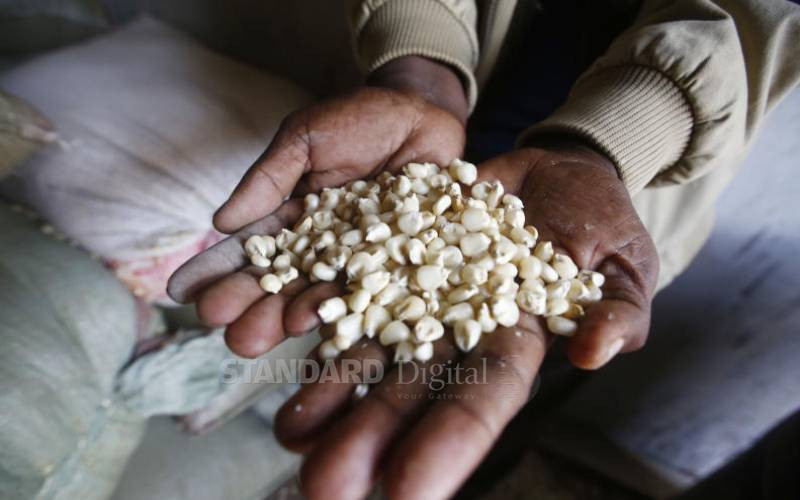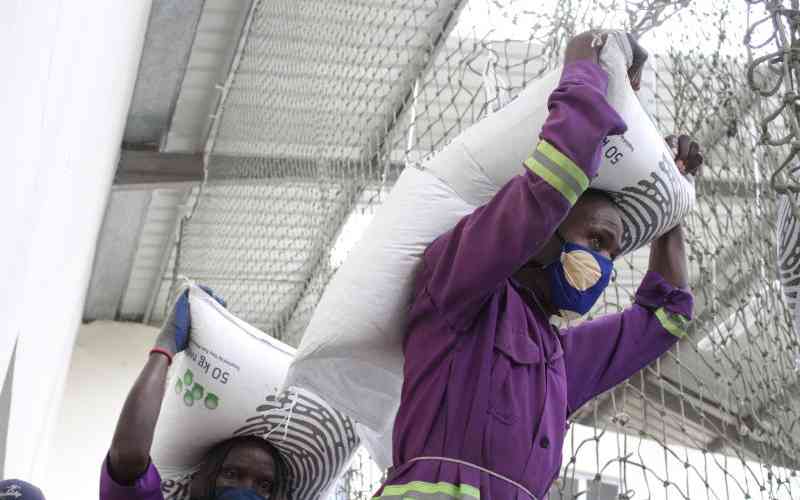By Edwin Makiche
Stephen Tulecha walks in his two-acre maize farm like an old tired man, his hands on his cheeks.  |
The strange disease attacks the crop and within weeks, the plant rots away. [Photos: Edwin Cheserek/Standard] |
Yet a few weeks earlier, the 32-year-old man watched with pride as the young crop sprouted, turning his farm to a green beauty.
The maize stalks have now withered and each day, more keep succumbing to a strange disease.
In the last two weeks, Tulecha had to cut all maize stalks in another farm to feed his cattle after the maize wilted before even flowering.
The father of three says this turn of events is just going to impoverish him and he only sees the future as being bleak — unless an instant solution is found. and that is the fear of many of his fellow villagers in Masare in Bomet County.
They depend on maize for subsistence as well as commercial use as the soil does not favour tea or other cash crops. Maize harvests take care of food and paying their children’s school fees besides other investments.
Strange disease
For the last three months, residents of Longisa and Sigor divisions in Bomet County are concerned about the strange disease that raided their farms.
The disease, which the farmers have simply named koroito, is fast dimming their hopes.
Leaves of affected plants begin yellowing and within weeks, the whole plant rots away. The disease spreads quite fast and if no immediate measures are taken, locals fear that it might affect the whole county and spread to neighbouring Narok County.
The response from the government and research institutions has ranged from slow to controversial.
Speaking to The Standard, Bomet District Agricultural officer Josphat Kioko said he was working day and night with other stakeholders to ensure that an immediate solution was found.
Kioko said he had forwarded samples of affected crops to Kenya Agricultural Research Institute of Agriculture(Kari) and Agri Quest, a Nairobi based private firm that offers support services to farmers, manufacturers and other stakeholders in the agricultural sector.
But the results given by the two firms are conflicting, a situation Kioko says has made it difficult for his department to conclusively handle the situation.
Stay informed. Subscribe to our newsletter
Kari recommends that farmers uproot and burn the affected crops as well as keeping their farms weed-free since weeds might host the fungus. It also advised farmers to sterilise farm implements after use.
Uprooting and burning
Agri Quest, however, attributes it to Meloidogyne, a devastating pest that attacks crops. They also detected botrytis cinerea, a common parasitic fungal disease that causes crop losses.
They recommend that farmers use both cultural and chemical methods including uprooting and burning or uprooting affected crops besides spraying them with fungicides.
Amid the two conflicting reports, Kioko says that his office is now at a crossroads on how to formulate a common policy and give an authoritative solution to the farmers’ peril.
A field visit by The Standard found several frustrated farmers who expressed uncertainty about their next course of action.
According to farmer Robert Koech, the disease is mysterious as it is the first time he has seen anything like that in the last ten years he has practised commercial maize farming.
He says: "Many of us were optimistic this year that the crop would do well as rainfall was reliable. But now look at this…" he says, spreading his hands helplessly over his two-acre plot under maize. Most of it is extensively damaged.
"It is a big loss… with the astronomical cost of seeds and fertilizers, it is going to be difficult to recover what I have invested," says a crestfallen Koech.
Although he planted his crop in early September last year to take advantage of the rain, the
strange disease attacked the crop as it began flowering and brought it down within weeks.
Koech planted ten packets of certified seeds at a cost of Sh300 per packet and used 150kg of fertilizer at Sh4,400 per 50kg bag. It cost him about Sh15,000, excluding labour.
Normally, he harvests between 25 and 27 bags from the farm. This year, however, he will be counting losses as the crop rots away.
To avoid total losses, some farmers have been clearing their farms of the diseased crops to pave way for planting alternative crops. The stalks are either given to their livestock or sold as silage.
Completely destroy
This is, however, discouraged by the agriculturalists who recommend that the farmers should completely destroy the crop since the cause of the disease has not been established.
In a region where everyone plants maize during the planting season — October through January — farmers now don’t know what else to plant. Some are ‘trying’ out vegetables as they wait for a solution so that they can go back to their usual maize crops.
The optimists are still planting maize, confident that the disease will be eliminated soon to allow their crop thrive.
Since maize is the region’s staple food crop, local leaders are now foreseeing a food crisis in the region if the status quo remains.
 The Standard Group Plc is a
multi-media organization with investments in media platforms spanning newspaper
print operations, television, radio broadcasting, digital and online services. The
Standard Group is recognized as a leading multi-media house in Kenya with a key
influence in matters of national and international interest.
The Standard Group Plc is a
multi-media organization with investments in media platforms spanning newspaper
print operations, television, radio broadcasting, digital and online services. The
Standard Group is recognized as a leading multi-media house in Kenya with a key
influence in matters of national and international interest.
 The Standard Group Plc is a
multi-media organization with investments in media platforms spanning newspaper
print operations, television, radio broadcasting, digital and online services. The
Standard Group is recognized as a leading multi-media house in Kenya with a key
influence in matters of national and international interest.
The Standard Group Plc is a
multi-media organization with investments in media platforms spanning newspaper
print operations, television, radio broadcasting, digital and online services. The
Standard Group is recognized as a leading multi-media house in Kenya with a key
influence in matters of national and international interest.










